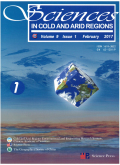- 钛学术文献服务平台 \
- 学术期刊 \
- 基础科学期刊 \
- 天文学、地球科学期刊 \
- 寒旱区科学(英文版)期刊 \
Changes in the global cryosphere and their impacts:A review and new perspective
Changes in the global cryosphere and their impacts:A review and new perspective
基本信息来源于合作网站,原文需代理用户跳转至来源网站获取
摘要:
As one of the five components of Earth's climatic system, the cryosphere has been undergoing rapid shrinking due to glob-al warming. Studies on the formation, evolution, distribution and dynamics of cryospheric components and their interac-tions with the human system are of increasing importance to society. In recent decades, the mass loss of glaciers, including the Greenland and Antarctic ice sheets, has accelerated. The extent of sea ice and snow cover has been shrinking, and per-mafrost has been degrading. The main sustainable development goals in cryospheric regions have been impacted. The shrinking of the cryosphere results in sea-level rise, which is currently affecting, or is soon expected to affect, 17 coastal megacities and some small island countries. In East Asia, South Asia and North America, climate anomalies are closely re-lated to the extent of Arctic sea ice and snow cover in the Northern Hemisphere. Increasing freshwater melting from the ice sheets and sea ice may be one reason for the slowdown in Atlantic meridional overturning circulation in the Arctic and Southern Oceans. The foundations of ports and infrastructure in the circum-Arctic permafrost regions suffer from the con-sequences of permafrost degradation. In high plateaus and mountainous regions, the cryosphere's shrinking has led to fluc-tuations in river runoff, caused water shortages and increased flooding risks in certain areas. These changes in cryospheric components have shown significant heterogeneity at different temporal and spatial scales. Our results suggest that the quantitative evaluation of future changes in the cryosphere still needs to be improved by enhancing existing observations and model simulations. Theoretical and methodological innovations are required to strengthen social economies' resilience to the impact of cryospheric change.

推荐文章
Diffusion in garnet: a review
High temperature and high pressure
Diffusion
Garnet
Point defects
Concentration-discharge patterns of weathering products from global rivers
Concentration-discharge
Rivers
Silicate weathering
Solutes
Global Mapper系统在海洋调查中的应用
Global Mapper
海洋调查
地形
信息
内容分析
关键词云
关键词热度
相关文献总数
(/次)
(/年)
文献信息
| 篇名 | Changes in the global cryosphere and their impacts:A review and new perspective | ||
| 来源期刊 | 寒旱区科学(英文版) | 学科 | |
| 关键词 | |||
| 年,卷(期) | 2020,(6) | 所属期刊栏目 | Reviews |
| 研究方向 | 页码范围 | 343-354 | |
| 页数 | 12页 | 分类号 | |
| 字数 | 语种 | 英文 | |
| DOI | |||
五维指标
引文网络
引文网络
二级参考文献 (257)
共引文献 (173)
参考文献 (60)
节点文献
引证文献 (0)
同被引文献 (0)
二级引证文献 (0)
1884(1)
- 参考文献(0)
- 二级参考文献(1)
1976(1)
- 参考文献(0)
- 二级参考文献(1)
1981(1)
- 参考文献(0)
- 二级参考文献(1)
1982(1)
- 参考文献(0)
- 二级参考文献(1)
1983(4)
- 参考文献(0)
- 二级参考文献(4)
1986(2)
- 参考文献(0)
- 二级参考文献(2)
1987(1)
- 参考文献(0)
- 二级参考文献(1)
1989(2)
- 参考文献(0)
- 二级参考文献(2)
1990(1)
- 参考文献(0)
- 二级参考文献(1)
1992(4)
- 参考文献(0)
- 二级参考文献(4)
1993(2)
- 参考文献(0)
- 二级参考文献(2)
1994(3)
- 参考文献(0)
- 二级参考文献(3)
1995(1)
- 参考文献(0)
- 二级参考文献(1)
1996(2)
- 参考文献(0)
- 二级参考文献(2)
1997(6)
- 参考文献(0)
- 二级参考文献(6)
1998(3)
- 参考文献(0)
- 二级参考文献(3)
1999(7)
- 参考文献(0)
- 二级参考文献(7)
2000(16)
- 参考文献(0)
- 二级参考文献(16)
2001(11)
- 参考文献(0)
- 二级参考文献(11)
2002(6)
- 参考文献(0)
- 二级参考文献(6)
2003(12)
- 参考文献(0)
- 二级参考文献(12)
2004(14)
- 参考文献(0)
- 二级参考文献(14)
2005(12)
- 参考文献(1)
- 二级参考文献(11)
2006(15)
- 参考文献(1)
- 二级参考文献(14)
2007(11)
- 参考文献(1)
- 二级参考文献(10)
2008(11)
- 参考文献(3)
- 二级参考文献(8)
2009(13)
- 参考文献(1)
- 二级参考文献(12)
2010(12)
- 参考文献(1)
- 二级参考文献(11)
2011(16)
- 参考文献(3)
- 二级参考文献(13)
2012(12)
- 参考文献(2)
- 二级参考文献(10)
2013(17)
- 参考文献(5)
- 二级参考文献(12)
2014(13)
- 参考文献(4)
- 二级参考文献(9)
2015(11)
- 参考文献(1)
- 二级参考文献(10)
2016(12)
- 参考文献(2)
- 二级参考文献(10)
2017(21)
- 参考文献(11)
- 二级参考文献(10)
2018(23)
- 参考文献(13)
- 二级参考文献(10)
2019(14)
- 参考文献(8)
- 二级参考文献(6)
2020(3)
- 参考文献(3)
- 二级参考文献(0)
2020(3)
- 参考文献(3)
- 二级参考文献(0)
- 引证文献(0)
- 二级引证文献(0)
引文网络交叉学科
相关学者/机构
期刊影响力
寒旱区科学(英文版)
主办单位:
中国科学院寒区旱区环境与工程研究所
科学出版社有限责任公司
出版周期:
双月刊
ISSN:
1674-3822
CN:
62-1201/P
开本:
出版地:
甘肃省兰州市东岗西路320号
邮发代号:
创刊时间:
语种:
eng
出版文献量(篇)
870
总下载数(次)
0
总被引数(次)
1072
期刊文献
相关文献
推荐文献
- 期刊分类
- 期刊(年)
- 期刊(期)
- 期刊推荐
力学
化学
地球物理学
地质学
基础科学综合
大学学报
天文学
天文学、地球科学
数学
气象学
海洋学
物理学
生物学
生物科学
自然地理学和测绘学
自然科学总论
自然科学理论与方法
资源科学
非线性科学与系统科学
寒旱区科学(英文版)2022
寒旱区科学(英文版)2021
寒旱区科学(英文版)2020
寒旱区科学(英文版)2019
寒旱区科学(英文版)2018
寒旱区科学(英文版)2017
寒旱区科学(英文版)2016
寒旱区科学(英文版)2015
寒旱区科学(英文版)2014
寒旱区科学(英文版)2013
寒旱区科学(英文版)2012
寒旱区科学(英文版)2011
寒旱区科学(英文版)2010
寒旱区科学(英文版)2009
寒旱区科学(英文版)2008
寒旱区科学(英文版)2020年第6期
寒旱区科学(英文版)2020年第5期
寒旱区科学(英文版)2020年第4期
寒旱区科学(英文版)2020年第3期
寒旱区科学(英文版)2020年第2期
寒旱区科学(英文版)2020年第1期

 免费查重
免费查重










